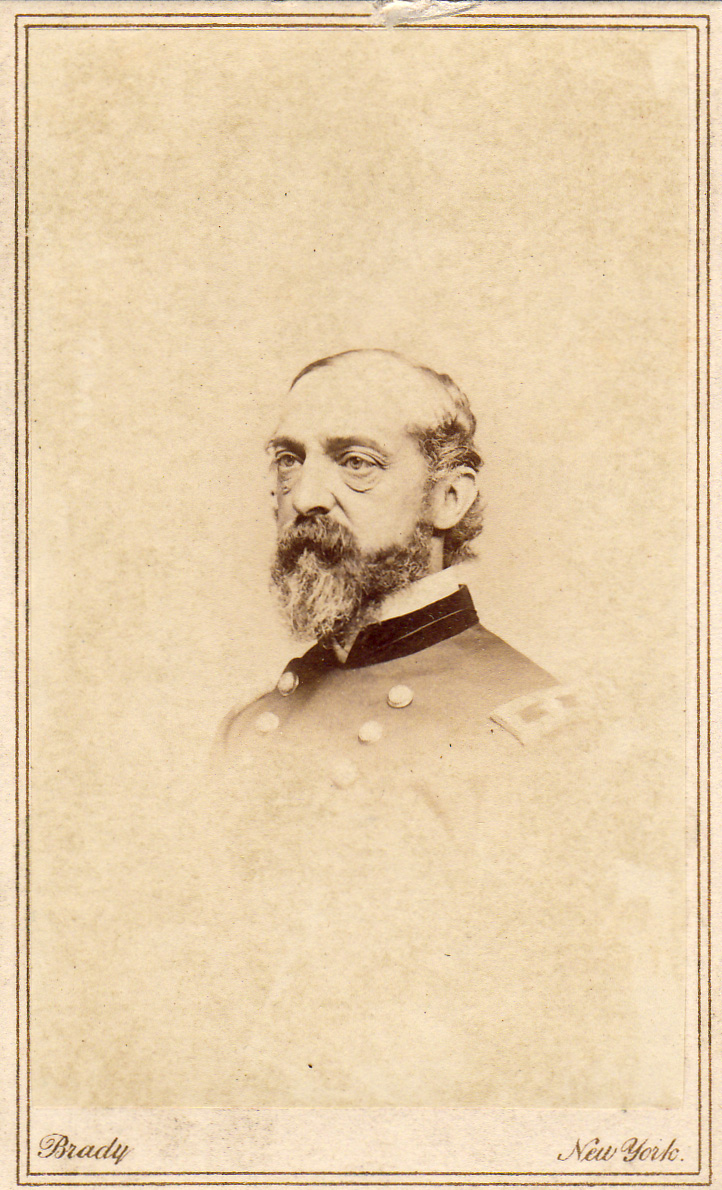George Meade was born in Cadiz, Spain, the son of the American naval agent posted there. The father, a successful Philadelphia merchant, moved his family back to the United States in 1817. Young Meade was educated at a school in Georgetown in the District of Columbia and at a military school near Philadelphia. He graduated from the U.S. Military Academy in 1835 as a brevet second lieutenant of artillery. After brief service in the 2nd Seminole War, he resigned his commission in 1836 and found work as a civil engineer on government surveys of the delta of the Mississippi River, the Texas boundary, and the northeastern boundary of the United States.
Having recently married, and fearing that War Department retrenchment would eliminate his contracted position, Meade reentered the army in 1842 as a second lieutenant in the Corps of Topographical Engineers. In this capacity he again worked on the survey of the northeastern boundary as well as on the survey of Delaware Bay.
 In the Mexican-American War (1846–48) Meade served under both Zachary Taylor and Winfield Scott and was present at the battles of Palo Alto, Resaca de la Palma, and Monterey, and the siege of Vera Cruz. Meade performed topographical duties, to include surveying enemy positions, selecting river crossings, and drawing maps. After the war he oversaw the construction of lighthouses on the Florida coast and along Delaware Bay, conducted mapping surveys of the Florida reefs, and was again (1849–50) engaged in hostilities against the Seminoles in Florida. In 1857 Captain Meade was placed in charge of the Northern Lakes Surveys.
In the Mexican-American War (1846–48) Meade served under both Zachary Taylor and Winfield Scott and was present at the battles of Palo Alto, Resaca de la Palma, and Monterey, and the siege of Vera Cruz. Meade performed topographical duties, to include surveying enemy positions, selecting river crossings, and drawing maps. After the war he oversaw the construction of lighthouses on the Florida coast and along Delaware Bay, conducted mapping surveys of the Florida reefs, and was again (1849–50) engaged in hostilities against the Seminoles in Florida. In 1857 Captain Meade was placed in charge of the Northern Lakes Surveys.
With the coming of the Civil War, Meade became a brigadier general of volunteers, commanding a brigade of the Pennsylvania Reserve Corps, which was sent to help in the construction of the defenses of Washington, D.C. Next, Meade and his troops served in the Peninsula Campaign, during which he was badly wounded at the Battle of Glendale, one of the Seven Days Battles in Virginia. He recovered at his home in Philadelphia before resuming brigade command in August 1862. After fighting in the Second Battle of Bull Run, he was given command of a division of First Corps, Army of the Potomac. The division fought at the battles of Stone Mountain and Antietam.
Meade was promoted to major general of volunteers in 1862. Meanwhile, his Regular Army rank was raised to major, Corps of Topographical Engineers. With the disbanding of the topographical engineers in 1863, he was to hold the same rank in the Corps of Engineers.
At the Battle of Fredericksburg, Meade commanded a division, and at Chancellorsville, he led a corps. In these defeats of the Union forces Meade had acquitted himself well, and on June 28, 1863, President Lincoln chose him to succeed Joseph Hooker as leader of the Army of the Potomac. Meade reluctantly accepted the appointment. A few days later his army clashed with the Army of Northern Virginia at Gettysburg, Pennsylvania, where the topographical engineer skillfully deployed his army for a defensive battle on favorable ground. Three days of fighting resulted in a resounding victory for the Union. Meade’s failure to pursue vigorously the retreating rebels greatly disappointed Lincoln, but the president refused to accept Meade’s offer to resign.
Back in Virginia for the remainder of the fall in 1863, he engaged Lee at the indecisive battles of Bristoe and Mine Run. General-in-chief of all the Union armies, Ulysses S. Grant, joined Meade at the latter’s headquarters, making Grant in actuality the real commander of the Army of the Potomac. Meade chafed at the new arrangement but generally performed effectively under Grant. After clashing with Lee’s army at the Wilderness, Spotsylvania, and Cold Harbor, Grant successfully carried off the siege of Petersburg, leading to Lee’s surrender. During the siege Meade was promoted to major general in the Regular Army.
After the war Meade held a succession of leadership positions in the Reconstruction era: at the Department of the East; the Third Military District; the Department of the South; and the Military Division of the Atlantic. He died at age fifty-seven in Philadelphia, while still on active duty, from complications of his old wounds and pneumonia.
Meade is not usually seen as a brilliant strategist. He grew increasingly cautious after Gettysburg, mainly out of a growing concern about the futility of attacking entrenched positions. Nevertheless, he was not afraid to engage the enemy and give his best effort. The victor of Gettysburg received many honors, including the thanks of Congress. Of all of the former engineers who became combat commanders of the federal armies, Meade achieved the most conspicuous success.